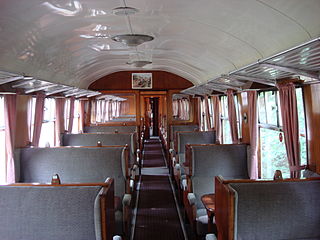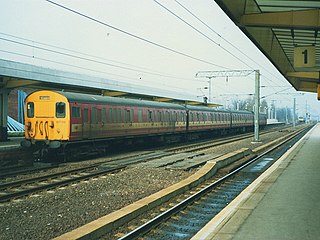
A Driving Brake Standard Open (DBSO) is a type of railway carriage in Great Britain, converted to operate as a control car; this is not to be confused with DVTs, such as those in InterCity 225 sets. Fourteen such vehicles, numbered 9701 to 9714, were converted from Mark 2F Brake Standard Open carriages. Modifications included adding a driving cab and TDM equipment to allow a locomotive to be driven remotely. Using a system known as push–pull, the driver in the DBSO can drive the locomotive, even though it is at the rear of the train.

The British RailClass 411 (4CEP) electric multiple units were built at Eastleigh works from 1956–63 for the newly electrified main lines in Kent. These units, which used a British Railways Mark 1 bodyshell, were based on the earlier Southern Railway 4 COR design, built in 1937. Variants of the class 411 design included the class 410 and class 412 4 BEP units, which contained a buffet car in place of a standard trailer. They were later used on services in Sussex and Hampshire; following the privatisation of British Rail in 1995, the units were used by the Connex South Central, Connex South Eastern and South West Trains franchises. They were replaced by Juniper, Desiro, and Electrostar units. The fleet's lifespan was 49 years. These units are the longest-lived BR Mark 1 EMUs.
British Rail reserved the TOPS Class 97 designation for departmental locomotives, which were used for special or engineering duties. They were therefore of several different classes, lumped together for numbering purposes. Some locomotives were converted from redundant engines, whilst others were purpose built. In 2008, Network Rail once again used Class 97 for signalling test locomotives.

The British Rail Class 31 diesel locomotives, also known as the Brush Type 2 and previously as Class 30, were built by Brush Traction from 1957-62. They were numbered in two series, D5500-D5699 and D5800-D5862. Construction of the first locomotive was completed in the final week of September 1957, and the handing-over took place on 31 October. The first Class 31 entered service in November 1957, after the launch of the Class 20 locomotive and was one of the Pilot Scheme locomotives ordered by British Railways to replace steam traction.

The British Rail Class 73 is a British electro-diesel locomotive. The type is unusual in that it can operate from the Southern Region's 650/750 V DC third-rail or an on-board diesel engine to allow it to operate on non-electrified routes. This makes it very versatile, although the diesel engine produces less power than is available from the third-rail supply so the locomotives are rarely operated outside of the former Southern Region of British Rail. Following the withdrawal and scrapping of the more powerful Class 74 electro-diesels in 1977, the Class 73 was unique on the British railway network until the introduction of the Class 88 electro-diesels in 2017. Ten locomotives have been scrapped.

The British Rail Class 489 (GLV) is a type of electric multiple unit, specially converted for use on Gatwick Express trains, from London Victoria to Gatwick Airport.

The British Rail Class 421 (4CIG) electric multiple units were built at BR's Holgate Road carriage works between 1964 and 1972. Units were built in two batches, and were initially introduced on services on the Brighton Main Line. Later units were introduced on services to Portsmouth. These units replaced older Southern Railway-designed units, such as the 5Bel "Brighton Belle" units, and 4Cor units. The fleet's lifespan was 46 years.

The British Rail Class 423, electric multiple unit passenger trains were mostly built by British Rail (BR) at York Works from 1967 to 1974, although the MBSOs and TSOs of the first 20, 7701-7720, were built at Derby Works. They have manually opening doors next to every seating row and were the last coaching stock built in this pattern for BR. They were mostly found working outer-suburban services in South London and rural services in Kent, Sussex and Hampshire, up to 2005 when they were finally replaced by Electrostar and Desiro units. The fleet had a working life of 38 years.

The British Rail Class 309 "Clacton Express" electric multiple units (EMUs) were built by British Rail (BR) York Carriage Works from 1962–1963. They were initially classified as Class AM9 before the introduction of TOPS. These units were the first express 25 kV alternating current (AC) units to be built by British Rail and were their first EMUs capable of 100 mph.

British Railways Mark 1 is the family designation for the first standardised designs of railway carriages built by British Railways (BR) from 1951 until 1974, now used only for charter services on the main lines or on preserved railways.

The Mark 2 family of railway carriages are British Rail's second design of carriages. They were built by British Rail workshops between 1964 and 1975. They were of steel construction.

The British Rail Mark 3 is a type of passenger carriage developed in response to growing competition from airlines and the car in the 1970s. A variant of the Mark 3 became the rolling stock for the High Speed Train (HST).
A wide variety of hauled coaches have been used on the railways of Ireland. This page lists all those since 1945.

The British Rail Class 307 electric multiple units were built by BR at Eastleigh Works from 1954 to 1956. They were initially classified as AM7 before the introduction of TOPS.

The British Rail Class 432 (4-REP) electric multiple unit passenger trains were built by BR at York Works from 1966 to 1967 and in 1974. The units were built to power the TC trailer units on services on the South West Main Line. Fifteen four-car units were eventually built. The motor coaches were new build, but the trailers were converted from Mk1 hauled stock. They were initially classified as Class 441 and numbered 3001–3015. This was later changed to Class 430, under which they spent the majority of their working lives. Shortly before withdrawal they were reclassified Class 432 and the units were renumbered as 2001–2015. The fleet had a lifespan of 26 years.

British Rail Class 416 (2-EPB) was a class of third-rail electric multiple units in service between 1953 and 1995. They were intended for inner suburban passenger services on London's Southern Electric network. There were two subclasses of Class 416: Class 416/1 to an SR design on salvaged 2-NOL underframes, built between 1953 and 1956, and Class 416/2 based on a British Railways Mark 1 coach design.

A First Open or FO, is a type of railway carriage used by British Rail and subsequent operators since privatisation. They were first produced as British Railways Mark 1, and subsequently Mark 2, Mark 3, and Mark 4 variants were produced. This type of carriage is an "open coach" because of the arrangement of the seats inside – other types of carriage may be corridor based variants (FK) or have a brake compartment.

The New Zealand British Rail Mark 2 carriages were built by British Rail Engineering Limited for British Rail in the early 1970s. From the mid-1990s, 150 were exported to New Zealand. After being rebuilt, refurbished and re-gauged, they entered service with a variety of operators on New Zealand's railway network. The carriages generally replaced older NZR 56-foot carriages, some of which had been in use for almost 70 years.

The Mid-Norfolk Railway has a large collection of heritage rolling stock, mostly relating to the post-war British Railways-era, from the 1950s to 1990s. The line holds several rolling-stock accomplishments:

















